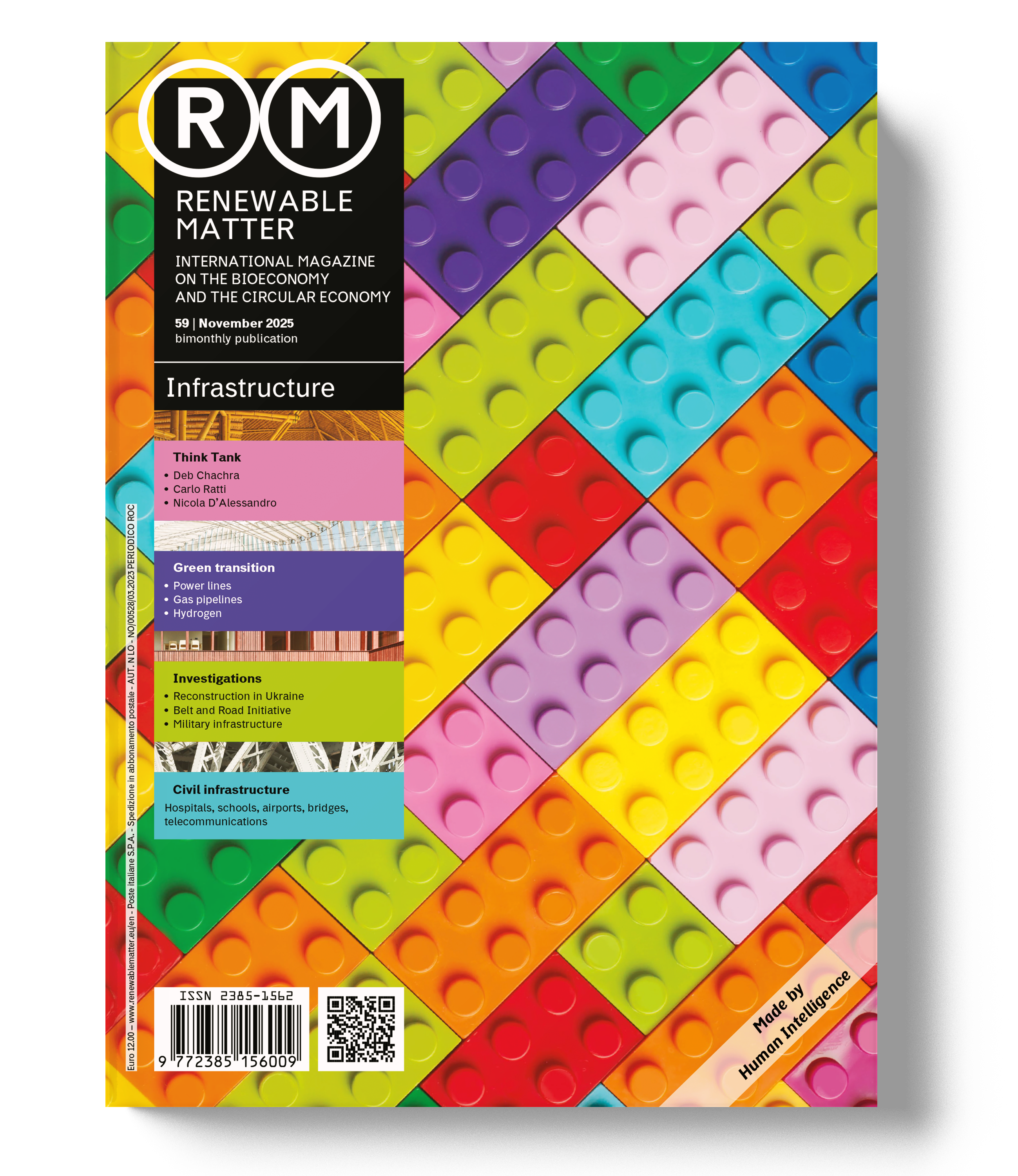*from Dubai
The equation is simple: if you want to decarbonise the economy, it will not be enough to have a final text here at COP28 calling for the phase-out of all fossil fuels, with emissions abated or not. As of 14 December, we will have to work to move $2.4 trillion by the end of the decade. Renewable Matter, in collaboration with National Geographic, interviewed Avinash Persaud, economist, special envoy of the Government of Barbados, and mastermind of the main climate finance reform initiative within the UNFCCC, the Bridgetown Initiative. The initiative pushes especially on the restructuring of multilateral development banks, such as the World Bank, and an intelligent debt restructuring of the most vulnerable and least developed countries.
Avinash Persaud photographed by Emanuele Bompan
We have almost reached the goal of mobilising $100 billion per year from 2020 to 2025 for climate finance. Yet, for economists like Lord Nicholas Stern, to decarbonise the economy and stay below the 1.5°C target we need $2.4 trillion to be disbursed in the form of loans, grants, guarantees and other financial forms. How can we achieve this by the end of the decade, in the symbolic year 2030?
The 2.4 trillion dollars include all kinds of financing and are needed to carry out projects, while the 100 billion was just public aid. However, more than half of this money is needed for projects for decarbonization that will generate revenue, so it must be found exclusively in the private sector, which needs to be lobbied on.
The second largest amount is projects for which there is no revenue but that generate savings. If I spend a dollar on a stronger sea wall, better drainage systems, or better anti-flood defences, it will save me $7 in the future. Consequently, I can borrow money for that because I can use the savings to pay the interest and pay back the borrower.
And then there’s the expenditure that generates no revenues and no savings. They are just costs. If I start borrowing for those things, I will soon drown in an ocean of debt. These costs are Loss and damage. So, when I have a low income community that's being wiped away by a flood, I need to relocate and rebuild the homes. If it needs to borrow for every climate disaster, it will be impossible for a vulnerable country to repay its debts. Today, about half of the increase in debt in vulnerable countries is related to loss and damage caused by natural disasters, which is why we have made a big push this year on Loss and Damage Fund, which is about grant-based support for those actions that have a cost.
However, for the Loss and Damage Fund, the pennies pledged here in Dubai are not enough. Given that these are grants from the public sector, how much do we need?
We need about $100 billion a year for Loss and Damage – the entirety of loss and damage is over 150 billion and rising as we fail to mitigate fast enough – but we think that the initial capitalisation of the loss and damage fund will come from taxpayers and public sector money.
Maybe that's the first few billion. However, we need to generate new revenue. This can be emissions-related taxes on shipping, on aviation, on methane leakages. Consumers are paying for this, but we need companies, shareholders, and capital, too, to contribute. A solution? A tax of a few percentage points on the profits of the fossil fuel industry.
We then need the resources for climate loans, both for mitigation and adaptation. Where do we find them?
The multilateral development banks as a group lend about $100 billion per year. We need them to be lending US$300 billion per year, which is what we need for the Adaptation Goals. They can get halfway there – and the World Bank has started on that journey – by using their existing capital better, such as leveraging their capital, and using less capital by guaranteeing not individual loans, but portfolios of loans. They can use Special Drawing Rights mixed with their capital, an IMF-based currency.
And those things could get us from 100 billion to 200 billion a year. To get to the last 100 billion, we will need to put in some more capital that could be spread out over ten years. So that's $10 billion per year. For countries like Italy that would be something like 350 million USD per year. You can't get a better way of leveraging a dollar for development because for every dollar that the development banks have, they can lend about 7 to $10.
We then have private institutions that, reacting to multilateralism and decisions such as the Paris Agreement, are redefining their priorities. How will the role of investment banks and funds change?
We must involve the private sector, for two reasons. First, the amount we need is a sum that the public sector does not have. Secondly, the private sector is already doing it in developed countries. 81% of renewable energy projects are funded by the private sector in rich countries. This shows the interest of banks and funds. The problem is that they do not invest in developing countries because the risks are higher. In Barbados, we offer the possibility of having the same tax rate for 25 years, regardless of the elected government, or the possibility of taking us to court if we renege on a contract, but in other countries, there are no such guarantees. We need systems that cover the risk premium. What we’re asking developing countries to do is to move faster than any country has ever done until now, however, the domestic savings in developing countries will not be enough. They have to import capital.
For so many countries the debt issue persists, making them unable to take new loans. How to do this?
They could restructure the debt, but they'd have to do it in an IMF program, which would give the creditors the confidence to come back. However, the countries are afraid of IMF programs. So, we need to make IMF programs friendlier to encourage more debt restructuring where debts are too high. There are countries that have borrowed from other countries: this debt could be cancelled as a measure of foreign policy.
It appears that Article 6 will not be completed again this year, de facto still postponing an international market on carbon credits. What role do these play in moving needed resources?
In the long run, carbon markets and prices will be important. The leap will be between domestic and cross-border markets. Domestic carbon markets are compliant, supported by the strength of domestic legislation. Cross-border markets, on the other hand, have no fiscal jurisdictions between countries. We are left with a voluntary market, but it does not work very well and it is tiny. If we count the time we talk about carbon markets versus what they are worth, it is hugely disproportionate: it only raises $2 billion a year, not even 1 percent of what it needs. So we need to create more national markets, which may not all have the same price of carbon, and establish cross-border taxes, such as a tax on shipping emissions. If we then allowed an offset to that tax anywhere in the world that meets certain conditions, we would have created a cross-border carbon market.
How can we read COP28 from the perspective of climate finance?
COP28 already delivered a lot when it comes to finance: it issued a loss damage fund, has delivered a recapitalisation of the Green Climate Fund for US$ 12,4 billion; has provided a deadline to help the multilateral development banks agree to pause clauses for past debts, and not just new debts; has led to a finance declaration, which is very much a reflection of the Bridgetown Initiative. I don't think we will get much more or should expect much more. There will be greater demands, but without finance nothing gets done.
Also read: CLIMATE FINANCE AND THE PARIS AGREEMENT, HOW EVERYTHING FITS TOGETHER
Where to look, then?
My focus is moving now to the MDBs spring meetings: we now need the multilateral developed banks to be three times bigger. The battleground for that is not COP. It's the spring and autumn bank meetings.
How to proceed on the phase out of fossil fuel subsidies?
I'm an economist by training. I instinctively dislike subsidies for harmful things. But I think the reality is that people are viewing it too simplistically because many of these subsidies are for consumers. I think the amount of subsidies to be reduced and transferred to safety is much less than the figures reported in the newspapers. We are in the range of $300 billion instead of $1.4 trillion. However, 300 billion is not a small amount of money. It makes a big difference for example for Loss and Damage.
Italy has been supportive of the Bridgetown Initiative?
Italy has supported significant funding of the Loss and Damage Fund, just as it has supported the Bridgetown Initiative in the G20 meetings.
We hope it will continue to do so in the G7. Mario Draghi has been proposed by Macron to be the next president of the European Union. How could he impact the European climate finance?
Mario Draghi is one of the most impressive people I know. He would definitely put Europe in a good position. We need to be united for the climate challenge, and right now we are not, under the pressure of a nationalism that increasingly denies the role of multilateralism at the global level. Mario Draghi would be a good resister of that trend.
This article is also available in Italian / Questo articolo è disponibile anche in italiano
Cover image: Jordan Opel, Unsplash



